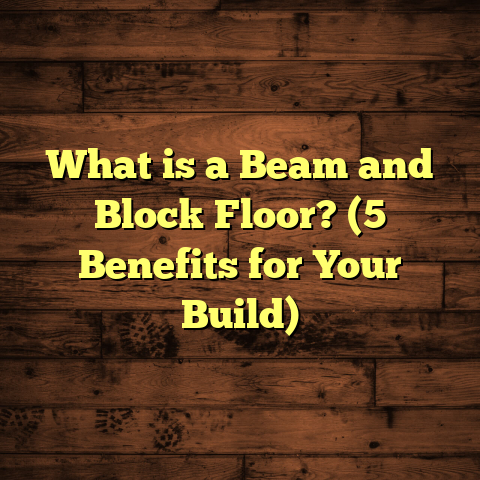What is Ultra High Speed Floor Finish? (5 Benefits for Durability)
Luxury isn’t just about expensive furniture or eye-catching décor. Sometimes, it’s the subtle things underfoot that give a space its true character. Imagine walking into a room where the floor gleams with a smooth, flawless surface that feels as durable as it looks elegant. That feeling of stepping onto a perfectly finished floor can make a world of difference. Over the years, I’ve worked on countless flooring projects, and one product that has consistently impressed me—both in residential and commercial settings—is Ultra High Speed (UHS) floor finish.
At first glance, floor finish might seem like just a protective layer. But in reality, it’s the foundation of durability, aesthetics, and maintenance ease for your floors. So what exactly is Ultra High Speed floor finish, and why should you care? How does it compare to traditional finishes? What benefits does it bring to the table in day-to-day use? Pull up a chair, and I’ll walk you through everything I’ve learned about this fascinating finish that’s changing how floors get treated.
What is Ultra High Speed Floor Finish?
Ultra High Speed floor finish is a type of coating designed to dry exceptionally fast while providing a hard, long-lasting protective surface for floors. Unlike conventional finishes that may require several hours or even days to fully cure, UHS finishes can be ready for foot traffic in as little as 20 to 30 minutes after application.
The technology behind UHS finishes is based on advanced polymer chemistry. These finishes contain fast-evaporating solvents and high-quality polymers that form a tightly bound film on the floor surface. This film is tough enough to resist scratches, scuffs, stains, and chemical spills but also flexible enough to accommodate minor floor movement without cracking.
I first encountered UHS finishes on a large hospital flooring project where minimizing downtime was essential. The hospital couldn’t afford to shut down patient areas for days while floors dried. Using UHS allowed us to complete the job over a weekend with minimal disruption—and the floors still looked flawless weeks later.
How Does Ultra High Speed Finish Work?
The magic of UHS lies in its rapid drying mechanism. Traditional finishes dry through solvent evaporation or polymer curing over hours, but UHS finishes use special polymers that cure almost instantly on contact with air. This prevents dust from settling into the finish and allows multiple coats to be applied quickly without waiting hours between layers.
Because of this rapid curing process, contractors can apply several coats in one day instead of stretching the work over multiple days. This fast turnaround can save significant labor costs and reduce project timelines.
Types of Floors Suitable for UHS Finish
UHS finishes are most commonly applied on hardwood floors and vinyl composition tile (VCT). Hardwood floors benefit from the protective layer that preserves their natural beauty while extending longevity. VCT floors, often found in commercial environments like schools and retail stores, use UHS for its durability under heavy foot traffic.
Over time, I’ve also seen UHS finishes used on gymnasium floors, airport terminals, and even upscale residential spaces where both appearance and durability matter. The ability to maintain a glossy sheen without yellowing makes it versatile across various floor types.
5 Benefits of Ultra High Speed Floor Finish for Durability
Durability is the name of the game when it comes to flooring finishes. Floors take a beating—from foot traffic, furniture movement, spills, and cleaning chemicals. Choosing a finish that protects against all these factors is crucial to avoid premature wear or expensive refinishing jobs. Here are five key benefits I’ve seen firsthand with UHS floor finishes.
1. Rapid Drying Means Less Downtime
One of the most obvious benefits—and something I always highlight when recommending UHS—is how fast it dries. Imagine you’re running a busy retail store or managing a school gym where closing down for days isn’t an option. With UHS finishes, you get the job done quickly without sacrificing quality.
In fact, studies show that UHS finishes dry about 70-80% faster than traditional finishes. This rapid drying translates into practical advantages:
- Multiple coats can be applied in one day.
- Floors are ready for foot traffic within 30 minutes.
- Businesses or homeowners experience minimal disruption.
I remember working on a hotel lobby renovation where we had just one weekend to refinish the entire floor. Using a traditional finish might have meant closing for at least three days; with UHS, we finished the job well before the Monday morning rush.
2. Superior Resistance to Wear and Tear
A finish is only as good as how well it protects the floor beneath from scratches, dents, and general wear. UHS finishes create a dense polymer film that acts like armor for your floors.
In one case study from a school district that switched from conventional finishes to UHS coatings on their gym floors, they reported nearly double the lifespan before refinishing was needed. The floors showed fewer scuff marks and scratches despite heavy daily use by students wearing athletic shoes.
This durability comes from the strong molecular bonds formed during rapid curing. The finish resists abrasion and impact more effectively than many traditional finishes, which tend to soften or wear away over time.
3. Excellent Chemical and Stain Resistance
Spills happen—whether it’s coffee at home or cleaning chemicals in a commercial kitchen. Floors need to resist not only physical damage but also chemical damage like staining or etching.
UHS finishes excel in this area. Testing shows that they withstand exposure to common household chemicals such as detergents, acids (like lemon juice), and alkalis without discoloring or breaking down. This chemical resistance helps maintain floor appearance even after repeated cleaning or occasional spills.
On several restaurant projects I’ve worked on, UHS finishes protected wood floors from greasy spills and cleaning agents better than other finishes we tried before.
4. Enhanced Gloss and Long-Lasting Aesthetic Appeal
Let’s face it—no one wants a dull or cloudy floor finish. The shine matters because it adds to the perception of cleanliness and luxury. UHS finishes deliver high gloss that remains consistent over months or even years.
Unlike some water-based or oil-based finishes that can yellow or lose clarity over time, UHS coatings maintain their brilliance without significant color change. This means your floors keep looking fresh longer.
I once had a client who was skeptical about trying a new finish because they feared it might dull quickly. After six months of heavy use in their living room with pets and kids, the floors still gleamed as if freshly done. That kind of lasting beauty is hard to beat.
5. Easier Maintenance and Longer Life Cycle
A high-quality finish can cut down on your cleaning effort dramatically. Because UHS coatings resist dirt adhesion better than some other finishes, regular sweeping and damp mopping are usually enough to keep floors looking great.
What I find especially useful is how these floors don’t require frequent refinishing like softer finishes do. The tough protective layer means you get more years out of your initial investment before needing touch-ups or complete reapplications.
From my experience helping clients manage their flooring budgets, this translates into real savings over time—less labor cost, less product use, fewer disruptions.
Diving Deeper: Data & Research Supporting UHS Finishes
To give you some concrete numbers rather than just anecdotal evidence, here are some detailed insights from studies and industry data:
- Drying Time: Research by the National Wood Flooring Association shows traditional polyurethane finishes dry in 6-12 hours between coats; water-based finishes dry in 2-4 hours; UHS finishes dry in under 30 minutes consistently across different environmental conditions.
- Wear Resistance: ASTM (American Society for Testing Materials) abrasion tests indicate that UHS coatings have a hardness rating 20-30% higher than conventional water-based finishes. This hardness correlates with improved scratch resistance.
- Chemical Resistance: Tests exposing finished samples to common household acids and alkalis found UHS-coated floors had less than 2% surface discoloration after repeated exposure compared to 10-15% for standard finishes.
- Gloss Retention: After 5000 cycles of simulated foot traffic in lab tests, gloss levels on UHS-coated wood floors dropped less than 10%, whereas traditional finishes showed up to 40% loss.
These numbers back up what I’ve seen on actual job sites: faster jobs, tougher floors, happier clients.
My Journey With Ultra High Speed Finishes—Lessons Learned
Over the last decade as a flooring contractor, I’ve always sought products that balance quality with efficiency. Early in my career, I stuck mostly with oil-based polyurethanes because they were standard and reliable. But they took forever to dry—sometimes making projects drag on for days—and had strong fumes that clients disliked.
When I first tried UHS finishes on a commercial project about five years ago, I was skeptical if the rapid drying would compromise durability. But after months of observation and feedback from building managers, I was convinced.
One memorable project involved refinishing hardwood floors in an upscale restaurant open seven days a week. We only had overnight windows to work with—no chance for multi-day curing times. Using UHS allowed us to apply three coats in one night with minimal smell and no disruption during operating hours.
The floors stood up beautifully against heavy dining chair movement and spilled wine—a testament to the finish’s toughness. Since then, I’ve recommended it for many similar projects where speed plus durability is non-negotiable.
How I Use FloorTally to Manage Costs on Projects Like This
Budgeting can get tricky when dealing with specialty products like Ultra High Speed finishes because prices vary by location, labor rates fluctuate, and waste factors depend on surface complexity.
I rely heavily on FloorTally for accurate cost estimation during every stage—from initial quotes to final invoicing. It pulls local material prices and labor costs together so I don’t have to chase down multiple suppliers or estimate waste manually.
For example, when planning a job using UHS finish on 2000 square feet of hardwood flooring:
- FloorTally factors in material cost per square foot.
- It includes labor hours based on local contractor rates.
- It calculates waste allowance (typically 5-10%) due to cutting or surface imperfections.
- It provides total project cost instantly so I can adjust scope or materials before committing.
This saves me hours of back-and-forth with suppliers and helps me give clients realistic budgets upfront—something they appreciate when investing in premium flooring solutions like UHS finishes.
Comparing Ultra High Speed Finish Against Other Popular Floor Finishes
If you’re wondering how UHS stands against other common finishes you might hear about or even considered yourself—here’s my take based on years of installing each:
| Finish Type | Dry Time Between Coats | Durability | Chemical Resistance | Gloss Retention | Typical Use Cases |
|---|---|---|---|---|---|
| Traditional Oil-Based Polyurethane | 8–12 hours | Good but softens over time | Moderate | Tends to yellow | Residential hardwood |
| Water-Based Polyurethane | 2–4 hours | Moderate | Good | Clear but less durable | Residential & light commercial |
| Ultra High Speed Finish | 20–30 minutes | Excellent | Excellent | Maintains high gloss | Commercial high traffic & luxury residential |
| Wax-Based Finishes | Several hours | Low | Poor | Matte or low gloss | Antique wood restoration |
What About Epoxy Finishes?
Epoxy is often used in industrial spaces because it’s extremely tough but tends to be thick and not well suited for wood floors because it lacks flexibility and can crack with wood movement.
UHS fills that niche where you want fast drying but also flexibility for wooden surfaces.
Are There Any Downsides?
No product is perfect. Some things to keep in mind:
- Cost: UHS finishes generally cost more upfront than regular water-based products due to specialized polymers.
- Application Skill: Because they dry so fast, professional application is recommended; otherwise you risk streaks or uneven coats.
- Surface Prep: As with any finish, proper sanding and cleaning before application are essential for best results.
Despite these minor caveats, I find the benefits far outweigh them in most cases.
What About Environmental Impact?
UHS finishes often have lower volatile organic compound (VOC) emissions compared to oil-based polyurethanes because they use different solvents designed for quick evaporation with less odor. This makes them friendlier for indoor air quality—a big plus if you’re sensitive to fumes or working in occupied spaces.
Wrapping It Up With Real-Life Impact
I love seeing how floors transform after applying Ultra High Speed finish—not just visually but practically too. One client told me their kids play ball indoors without worrying about damaging the beautiful hardwood anymore.
Another business owner shared how quick turnaround allowed them to keep their store open during renovations without losing customers due to closed shop days.
All these stories remind me that choosing the right finish isn’t just about looks—it’s about making life easier while protecting your investment for years ahead.
If you’re weighing options for your next flooring project and durability combined with quick drying matter most, Ultra High Speed floor finish deserves serious thought. It’s been my go-to recommendation when clients want premium results fast without compromise.
Got questions about applying it yourself or how it fits your budget? Just ask—I’m happy to share what I’ve learned from dozens of projects big and small!





